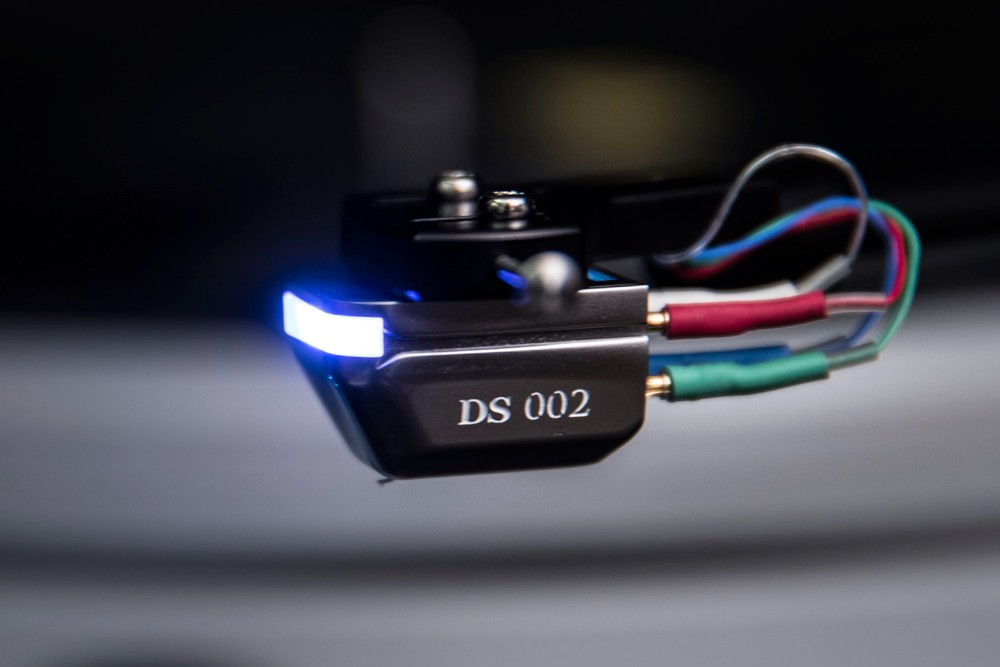
So far, I have reviewed the DS Audio DS-W1 and its phono stage, the DS Master1 with its incredible DS Master1 phono stage and now, here’s my review for the new DS 002 cartridge with its matching phono stage. All of these are optical cartridges and can only be used with one of the DS Audio phono stages, and the phono stages only work with their optical cartridges. While the DS Audio optical cartridges and phono stages are a closed system, they can be mixed and matched among themselves. This opens some interesting ways to upgrade, and I understand they are working on a trade-in program.
Let me mention two things before I get started with this review. While visiting with Garth Leerer of Musical Surroundings when he came over to hear the DS Master1 in my system, I told Garth, “I can tell you this, after living for three years with the Soundsmith Strain Gauge and now with the DS-W1, I’m not interested in returning to traditional cartridge technologies as better alternatives to traditional magnetic cartridges.” There are a couple of reasons why I feel this way. First, I don’t want to have to fool with a phono preamp and a step-up transformer. These devices at there best add some noise, hum, and money to a system that a setup like a strain gauge or an optical cartridge doesn’t. And second, the first reason wouldn’t matter if magnetic cartridges were vastly better, but they are not. If you want to know more about why I feel that way, read my Dagogo column from a couple of years ago, “The Beatnik on the Best Way to Play LPs.”
Still, both Peter Ledermann of Soundsmith and Garth Leerer tell me that this isn’t the way most American’s see it. They say that the European market is much more open to such closed systems. I don’t know why Americans like separates so much. One of, if not the best, amp I have ever heard was the ASR Emitter Integrated. As much as I loved the Benz Ebony TR, the EMT TSD-15, the Miyabi Standard, which is my all-time favorite, and the Shindo SPU are all very low-output devices that need a really good transformer and a great phono stage. Even with the Shindo Giscours and the Auditorium 23 Hommage SUT, I could never totally eliminate hum or get as quite a background as the DS Audio Optical cartridges.
Description and Installation
Like the other DS Audio optical cartridges, the DS 002 doesn’t use a fixed array of magnets and coils that almost all phono cartridges use. Instead, it uses a fixed LED and an optical sensor to respond to the mechanical movement of the record grooves that modulate its Shibata-tipped cantilever into electricity. If you are interested in the technical side of how the DS Audio Optical cartridges work, look at my 2016 review of the DS-W1 for Dagogo.
The DS 002, like the DS Master1, uses a newly-designed micro-optic sensor which is positioned closer to the stylus, resulting in a shorter optical signal path. It also uses the new wire-suspended cantilever. On the DS 002, the cantilever is aluminum and the stylus tip is a Shibata-shaped diamond. These changes create significant improvements in channel separation over the DS-W1.
I asked how the DS 002 and the DS Master1 cartridges are different other than the cantilever material and stylus shape. According to Mr. Tetsuaki (Aki) Aoyagi, the DS Master1 body is made of “Ultra Duralumin” while the DS 002 is made of aluminum. “Ultra Duralumin” is an aluminum alloy that combines copper and magnesium with aluminum. Because of its lightness and other desirable physical properties, it has lower coloration than the aluminum body of the DS 002. According to Mr. Aki, the DS Master1’s parts are selected, measured and matched to much tighter tolerances. I can hear this difference with ease, but let’s be honest, there should be a discernible difference between cartridges when one costs four times more than the other.
The DS 002 cartridge itself is rather plain looking, and the phono stage looks very small compared to the DS Master1’s big beast of a phono stage, but it doesn’t look small compared to the DS-W1 phono stage. The DS 002 phono equalizer/preamp, like all the new DS Audio equalizer/preamps, has an output that uses the RIAA equalization curve.
Installation was straightforward and simple. My review system consisted of my Teresonic Ingenium speakers driven by the LTA MZ-2S integrated amp and the turntable was my AMG Viella V12 with their V12 Turbo tonearm. All of the cables were Duelund tinned-copper, and the power cords were from Audience.
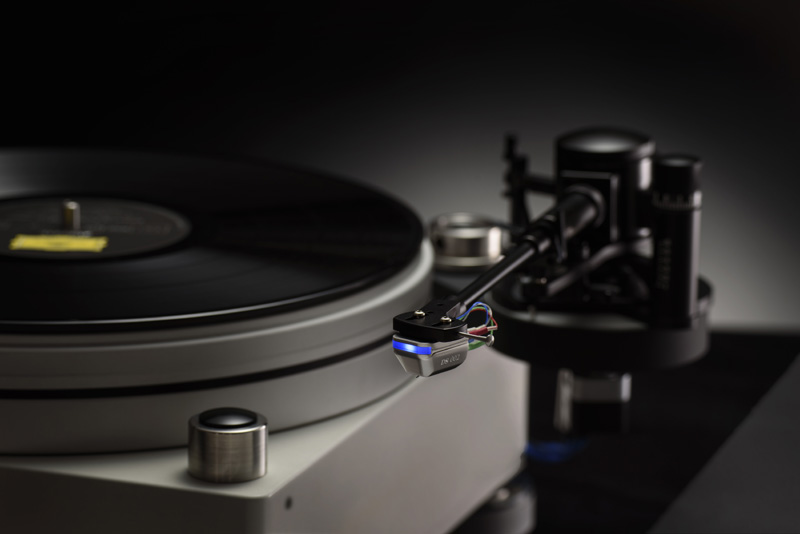
Listening
It would have been fairer to this cartridge if I had reviewed it first instead of after living with the DS-W1 and the game-changing DS Master1. The DS 002 would have been the perfect cartridge to have reviewed after living with the Soundsmith Strain Gauge. I could have told you about all the things it does that I have never heard before from a cartridge except for maybe the London Decca cartridge, but even the newest London Reference doesn’t really track well enough for a modern cartridge. The DS 002 has even less haze than the Strain Gauge and much less than any magnetic cartridge except for the Decca.
If you have never listened to a cartridge without with the haze that comes from a cantilever vibrating between magnets, you may find it hard to understand how special such cartridges are. We have become so accustomed to that sound that many think it is just part of the vinyl sound. The DS 002 literally flings open the window on the musical performance, and it is a very clear day with no fog between you and the performance. This remarkable improvement in clarity and sounding alive is hard to live without once you hear it.
When describing the DS-W1, I said that my early impressions of the DS-W1 in my system were that it was more like tape than vinyl. I wasn’t saying it sounded just like a reel-to-reel setup, but that the smooth, dynamic sound without the noise I usually hear from record grooves reminded me more of the sound of magnetic tape than of music reproduced by a magnetic cartridge. The DS Master1 sounds even more like tape in that it is even quieter in the grooves, bolder and has richer tones and better scale. The DS 002 sounds a little less like tape. To put this in perspective, it sounds more like tape than my Soundsmith Strain Gauge, but less like tape than the two other DS Audio cartridges.
I know you’re asking what I mean by all of that. Well, the Strain Gauge reproduced the cleanest, clearest, most transparent midrange and top end I had heard combined with the fastest, most dynamic bass. The Soundsmith Strain Gauge also produced the widest and most three-dimensional soundstage I had heard up to that time. The DS-W1 brought nearly all of this to the party and added more harmonics and a much better musical tone, but the soundstage was not nearly as wide. I was more than willing to give up soundstage width for the sound of the tonal richness and aliveness of the DS-W1, but many were not. So, what I’m telling you is that the DS 002 falls in between the Strain Gauge and the DS-W1. It has all of the clarity and transparency of the Strain Gauge and most of its soundstage width combined with a lot of the DS-W1’s tonal richness and aliveness. I think most people will find the DS 002 to be the best of both worlds.
In the DS-W1 review, I talked about how certain instruments sounded, so I thought I’d talk about that with the DS 002 and makes some comparisons with other cartridges.
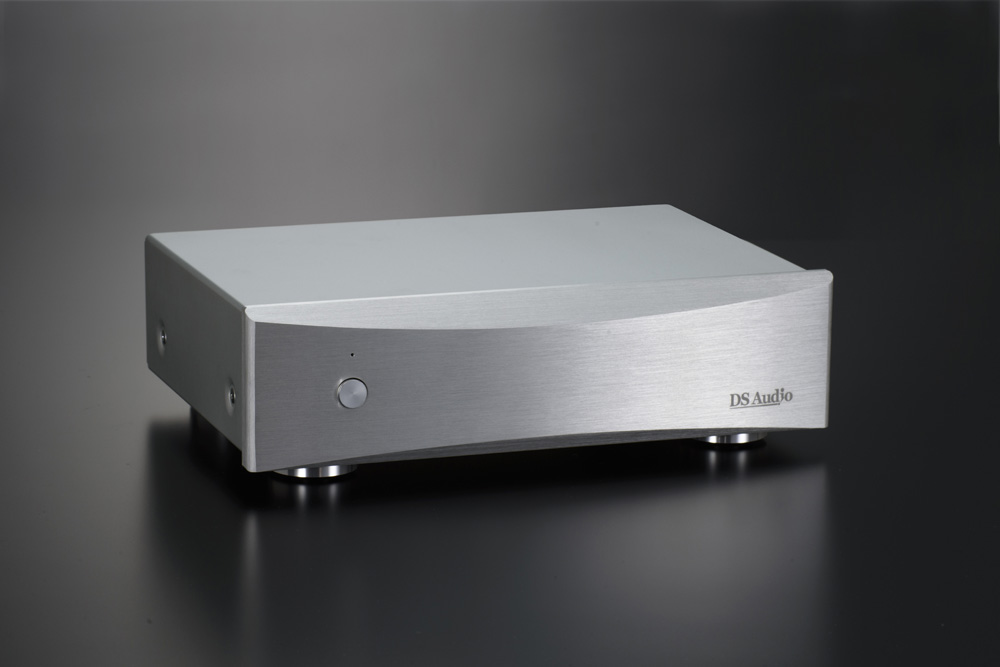
Violins, Violas, Cellos, and Most Importantly Fiddles
To me, strings are a big test for any system. The DS 002 enabled my system to play bowed strings with power and musicality, but the sound wasn’t quite as incredibly sweet as with the DS-W1. One of my favorite recordings is King of the Cellist, Starker Plays Kodaly. This is one of the most beautiful recordings of a cello I have ever heard. With the DS 002 cartridge in the system, the cello wasn’t quite as warm and full-bodied as with the DS-W1, but it had an aliveness that was incredibly engaging in a way that was better. You could hear the quickness and snap of Starker’s fingers as they moved up and down the fingerboard. The difference with the DS 002 and the DS-W1 from the Miyabi was that the fingering and the bowing sounded as if they came from the same instrument using the DS 002. In my experience, this is not an easy thing to pull of with a cello recording.
On other recordings, violins and violas sounded just as good as the cello, very sweet, never the least bit bright, and just like the DS-W1. I have to admit that on poorer recordings, the sound could be slightly more strident. Massed strings were extended, powerful but not quite as full-bodied as with the DS-W1, but more so than with the Strain Gauge. Massed strings had much better scale and covered a more realistic space in the soundstage with the DS 002 in my system.
I listen to a lot of bluegrass music, so it is important to me that a system can make a violin sound like a fiddle when it is played that way. With the DS 002, I could hear the speed of a fiddle. Norman Blake’s more aggressive style of fiddle playing came across with all the musical aggression one could want. My favorite jazz violin payer is Stéphane Grappelli. I put on an LP to hear how he sounded on this system, and before I knew it, I had listened to two complete LPs. It was much more involving than the strain gauge but not quite as full bodied as the DS-W1.
Plucked Stringed Instruments
Guitars, basses, mandolins and dulcimers sounded quicker and more like the real instruments being reproduced with the DS 002 than with any cartridge I have ever heard other than the DS Master1. It didn’t matter whether I was listening to a blues guitar, a stand-up bass in a jazz group or banjos or mandolins in a bluegrass group, they all had great presence. On these instruments, I heard superb tonality, harmonic structure and texture.
Like its two siblings, the DS 002 was incredible with any genre of guitar music. It didn’t matter if I was listening to Wes Montgomery, Julian Bream, Hendrix, Clapton or Chet Atkins I was always drawn into the performance. The guitars had great harmonic structure, texture, and real tonality.
As I’ve said, I listen to a lot of bluegrass, and it’s a music genre with lots of emotion and incredible micro-dynamics from all the different handmade small, plucked string instruments. The DS 002 reproduced the speed and emotion of the music wonderfully. While it wasn’t quite as sweet as the DS-W1, the DS 002’s combination of a quicker leading edge and more presence enabled me to experience the soul of a bluegrass performance in an exciting and emotional way.
I always include the piano in this group. The DS 002 sounded powerful with great air within and around the piano. It lets me easily hear how hard or easy the pianist struck the notes, if a note was sustained or if the note had been quickly released. The DS 002 also allowed me to hear the incredible dynamics of a piano, but I could also hear the overtones from the other strings inside the wooden instrument.
Horns and Woodwinds
I probably listen to more jazz than any other genre, so how my system plays horns and woodwinds is very important. To play woodwinds correctly, a system has to have balance from the upper bass through the top-end. It is necessary to have more than balance, though. These instruments move small amounts of air, but the air comes across as an essential part of their sound. You can hear it when you listen to woodwinds live. I preferred the DS-W1 with solo woodwinds, but I preferred the DS 002 with multiple instruments, especially with brass horns in a big band. With any of the DS Audio Optical cartridges, my system’s reproduction of the harmonics of woodwinds was the best I have heard. The air associated with these instruments is better with the DS 002 and even better with the DS Master1.The air and the sound of the instruments are more a part of one another with the DS Marter1.
Drums and Percussion
Drums often carry the rhythm and pace of a performance. I think that’s what I have always considered when judging the ability of a system to play drums. It’s easy to put together a system that robs all the weight and substance while you attempt to have lightning fast and tight bass. Often, you also end up finding out that you have sacrificed the bloom and warmth of the bass. To get drums right is even more difficult for me as I have a very low tolerance for bass that is the least bit boomy.
The DS 002 enabled my system to have drive and power from drums with plenty of air and warmth and no boom. The truth is, what any of the DS Audio optical cartridges do for drums makes them so much more lifelike that it’s hard to overstate how good they sound. I haven’t heard drums that move me like this with any other cartridge, there are my memory of the London Decca cartridges of the seventies. Using the DS 002 resulted in better definition of the air and dimensionally of drums. I think the key factors the DS 002 brings to drums are the ability to give weight and scale to drums without giving up speed.
Let’s take a moment to talk about cymbals; it would be a shame to get all the things about a drum kit sounding great, but then have tinny sounding cymbals or sandpaper sounding brushes. Cymbals can range in sound from a startling crash to a bright, brassy sound or a silvery shimmer. All cymbals do not sound alike just as all drums don’t; when your system plays cymbals right, it will let you hear those differences with ease, and they will still sound very natural. With either the DS-W1 or the DS 002 in my system cymbals sounded natural with apparent ease; however, the placement of the drummer’s brushes on either the drums or the cymbals was easier to hear with the DS 002.
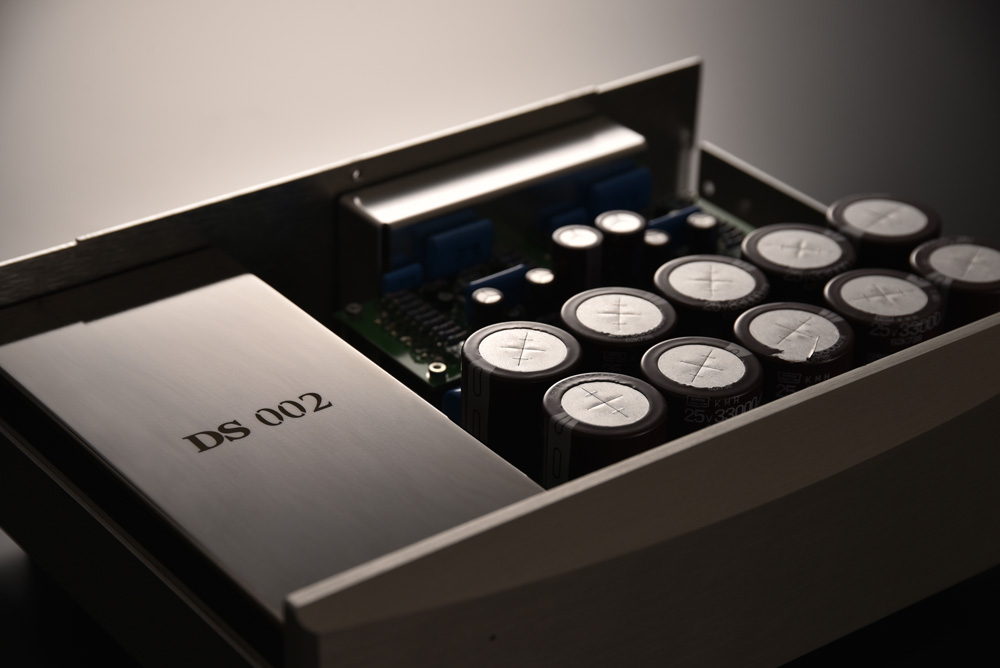
The Most Important Instrument, the Human Voice
The most important instrument for my system to get right is the human voice. I want to hear as close to real human beings in the room with me as possible. The most important thing is that voices should never sound like someone is inside a box. I want my system to have enough transparency to get the boxes out of the way and have enough articulation that voices can sound very lifelike. I look for a system that will allow me to hear the space and context of where the voice has been recorded. The first time I heard what I’m looking for was with the Teresonic Ingenium XR Silver speakers, the Wavac EC300B amp, the Shindo Giscours preamp and the Shindo 301 turntable system. I was shocked that voices could sound, as I described it, “scary real.”
So, this is the final test for any component I review. The DS 002 passed this test with flying colors. Voices were believable, they had immediacy and just seemed to be right in the room with me. The overall experience when the voices are right is very emotionally involving and just pulls me right into the performance. I think part of what makes the voices “scary real” is not only presence but also temporal realism. I think one of the things that set live music apart from recorded music is timing. The timing and flow of music seldom seem correct when played back on an audio system. It seems to me that tape and phono cartridges that are displacement-reading devices do this better than any phono cartridge that uses magnets. I’m guessing that the movement of the coils or the magnets simply blurs the timing to some small extent. As good as the above mentioned Shindo system was with voices, the DS Audio optical cartridges take the realism of voices to a whole new level.
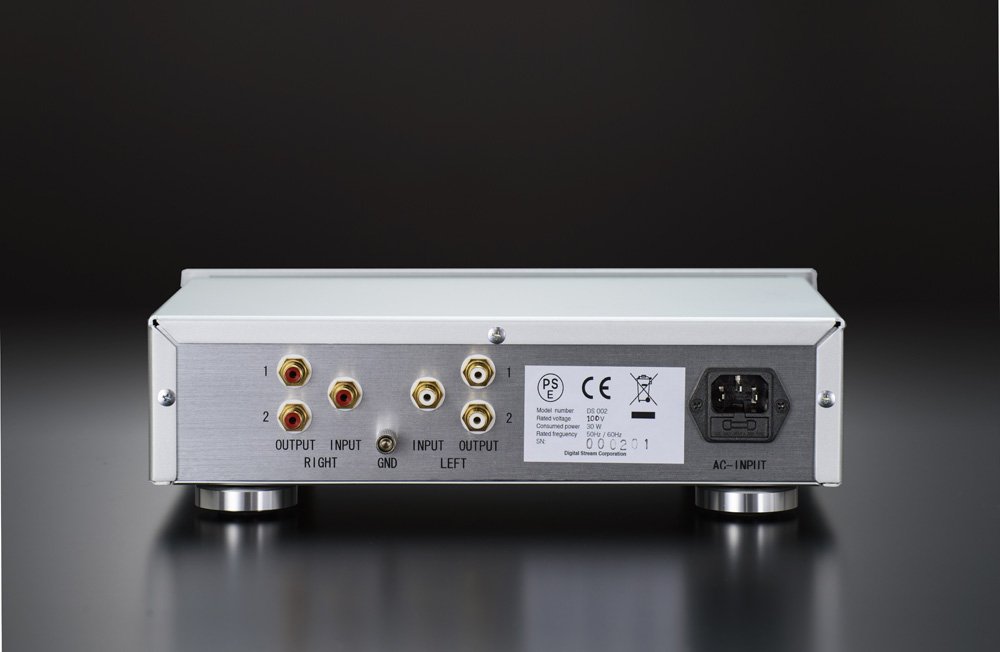
Soundstage
If you’ve been reading my reviews for long, you know that producing a huge holographic soundstage isn’t the most important thing to me. I think that kind of soundstaging is neat, but I don’t think it has much to do with the emotional enjoyment of a musical event, and sometimes it distracts from the performance. Still, it is important to most audiophiles, so I feel I must share something about how a component I am reviewing performs in this area. This is an area where the DS-W1 is different from most modern cartridges in a way that would bother most audiophiles. While, the DS-W1 has incredible depth, it has less depth than most audiophiles would expect. The new design of the DS Master1 and the DS 002 cartridges present a wide and deep, coherent soundstage without any exaggerated, “phasey sounds” that distract from the musical performance.
Conclusion
The DS Audio line of optical cartridges is all about pure fidelity and great harmonics played with rich and beautiful tonal color. They offer natural and realistic warmth without giving up speed or detail, and they have a temporal realism that is closer to live music than I have heard from any magnetic cartridge. In my conclusion to the DS Master1 review, I said, “I won’t go on and on comparing these three combinations. It’s pretty simple, the complete DS Master1 system is the best that I have ever heard, the combo of the DS Master1 cartridge and the DS-W1 preamp is the second best, and the total DS-W1 is the third-place winner. To round out the five best phono cartridges I have ever heard in my system, fourth place would go to the Soundsmith Strain Gauge, and fifth place would go to the Miyabi Standard moving coil with the Shindo Giscours preamp. The area where the DS Audio cartridges are better than the Strain Gauge is their ability to deliver beautiful, rich tones and wonderful harmonics. The place where the optical and Strain Gauge cartridges are better than the Miyabi Standard and Shindo combo is their lack of smear that comes from the magnets or coils moving and vibrating. I would like to say that I could live happily with any of the DS Audio Optical Cartridge Systems I have heard. I am dying to hear their new entry-level optical cartridge system.”
Well, now I have heard it, and the DS 002 is wonderful. It ranks just behind Master1. The DS-W1 has been discontinued. What I can’t wait to hear next is the new DS W-2 with the same updates to the cartridge and a boron cantilever with a Micro-Ridge stylus. It will make its debut at CES in January, and I’ll be there to hear it and interview the cartridge designer, Mr. Tetsuaki (Aki) Aoyagi. For now, the DS Audio DS 002 is the best cartridge I have heard for under $10,000. In fact, with it’s included phono stage for $5,500.
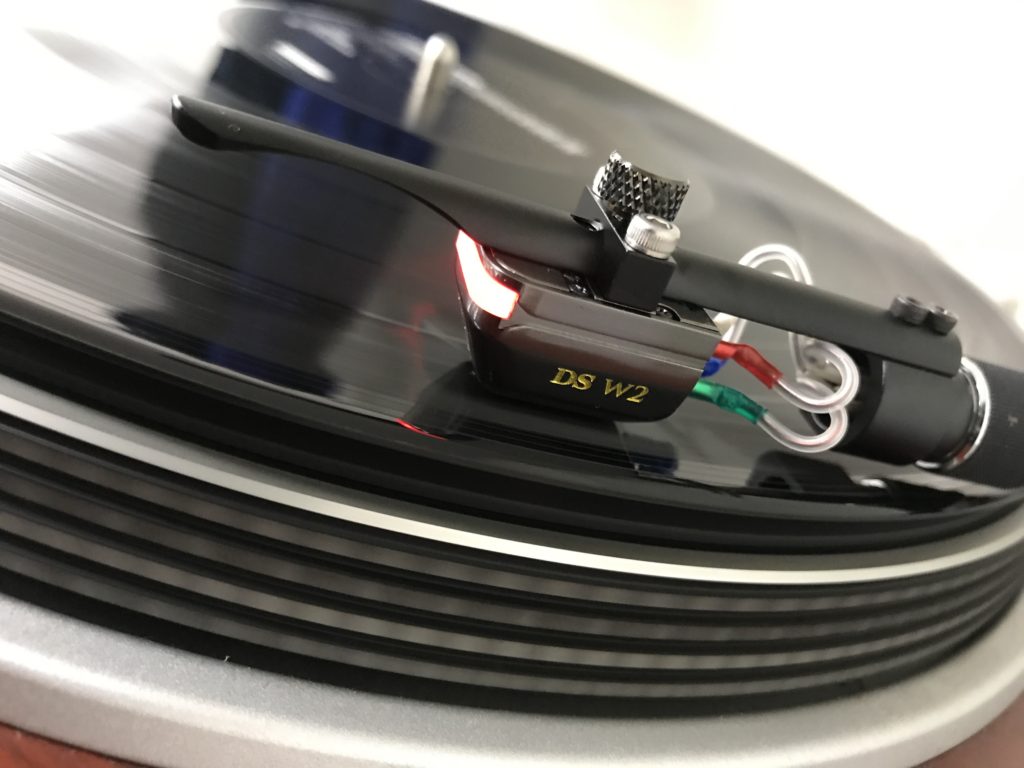
DS 002 Optical Cartridge Specifications
Signal output: Photoelectric conversion
Channel separation: 25dB or more
Output signal level: 500mV
Cantilever: Aluminum
Body material: Aluminum
Tracking force: 1.6g–1.8g
Stylus: Shibata
Weight: 8.1g
Price: $2,250
DS 002 Equalizer
Rated output voltage: 500mV
Impedance: 120 ohms
Input: RCA
Output: Two stereo pairs on RCA jacks
Size: 310 x 920 x 235mm
Weight: 4.7kg
Price: $3,250
MUSICAL SURROUNDINGS (U.S. Importer)
(510) 547-5006
info@musicalsurroundings.com
http://www.musicalsurroundings.com

Thank you for the interesting review. I currently own and play a number of MM and MC cartridges, including the marvelous Ortofon SPUs, depending on the source: recent stereo LP, vintage stereo LP, classical/opera, mono vintage LP and 78 (NOT acoustic). How well do you believe that the DS Audio system or the Soundsmith Straingauge systems will work with other than “modern” (post 1960) LPs, including mono? I don’t expect much love with 78s due to the wider grooves, but I wonder how well these systems work with vintage stereo and mono recordings.
It seems that the optical sensor would be a simpler version of that found in a digital camera. I would expect it to be an rray of size XxY.
What are the row and column values?
Nobody mentions this important factor which would define the resolution limits of such a device.